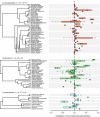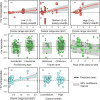Using host species traits to understand the consequences of resource provisioning for host-parasite interactions
- PMID: 29023699
- PMCID: PMC5836909
- DOI: 10.1111/1365-2656.12765
Using host species traits to understand the consequences of resource provisioning for host-parasite interactions
Abstract
Supplemental food provided to wildlife by human activities can be more abundant and predictable than natural resources, and subsequent changes in wildlife ecology can have profound impacts on host-parasite interactions. Identifying traits of species associated with increases or decreases in infection outcomes with resource provisioning could improve assessments of wildlife most prone to disease risks in changing environments. We conducted a phylogenetic meta-analysis of 342 host-parasite interactions across 56 wildlife species and three broad taxonomic groups of parasites to identify host-level traits that influence whether provisioning is associated with increases or decreases in infection. We predicted dietary generalists that capitalize on novel food would show greater infection in provisioned habitats owing to population growth and food-borne exposure to contaminants and parasite infectious stages. Similarly, species with fast life histories could experience stronger demographic and immunological benefits from provisioning that affect parasite transmission. We also predicted that wide-ranging and migratory behaviours could increase infection risks with provisioning if concentrated and non-seasonal foods promote dense aggregations that increase exposure to parasites. We found that provisioning increased infection with bacteria, viruses, fungi and protozoa (i.e. microparasites) most for wide-ranging, dietary generalist host species. Effect sizes for ectoparasites were also highest for host species with large home ranges but were instead lowest for dietary generalists. In contrast, the type of provisioning was a stronger correlate of infection outcomes for helminths than host species traits. Our analysis highlights host traits related to movement and feeding behaviour as important determinants of whether species experience greater infection with supplemental feeding. These results could help prioritize monitoring wildlife with particular trait profiles in anthropogenic habitats to reduce infectious disease risks in provisioned populations.
Keywords: conservation; consumer-resource interactions; dietary breadth; home range; infectious disease; parasitism; phylogenetic meta-analysis; supplemental feeding; urbanization.
© 2017 The Authors. Journal of Animal Ecology published by John Wiley & Sons Ltd on behalf of British Ecological Society.
Figures



Similar articles
-
The predicted impact of resource provisioning on the epidemiological responses of different parasites.J Anim Ecol. 2022 Aug;91(8):1719-1730. doi: 10.1111/1365-2656.13751. Epub 2022 Jun 14. J Anim Ecol. 2022. PMID: 35643978 Free PMC article.
-
Linking anthropogenic resources to wildlife-pathogen dynamics: a review and meta-analysis.Ecol Lett. 2015 May;18(5):483-95. doi: 10.1111/ele.12428. Epub 2015 Mar 21. Ecol Lett. 2015. PMID: 25808224 Free PMC article. Review.
-
From wetland specialist to hand-fed generalist: shifts in diet and condition with provisioning for a recently urbanized wading bird.Philos Trans R Soc Lond B Biol Sci. 2018 May 5;373(1745):20170100. doi: 10.1098/rstb.2017.0100. Philos Trans R Soc Lond B Biol Sci. 2018. PMID: 29531152 Free PMC article.
-
Food for contagion: synthesis and future directions for studying host-parasite responses to resource shifts in anthropogenic environments.Philos Trans R Soc Lond B Biol Sci. 2018 May 5;373(1745):20170102. doi: 10.1098/rstb.2017.0102. Philos Trans R Soc Lond B Biol Sci. 2018. PMID: 29531154 Free PMC article. Review.
-
Host Dispersal Responses to Resource Supplementation Determine Pathogen Spread in Wildlife Metapopulations.Am Nat. 2018 Oct;192(4):503-517. doi: 10.1086/699477. Epub 2018 Aug 15. Am Nat. 2018. PMID: 30205031
Cited by
-
Association between anthropization and rodent reservoirs of zoonotic pathogens in Northwestern Mexico.PLoS One. 2024 Feb 22;19(2):e0298976. doi: 10.1371/journal.pone.0298976. eCollection 2024. PLoS One. 2024. PMID: 38386681 Free PMC article.
-
Parasites of an Arctic scavenger; the wolverine (Gulo gulo).Int J Parasitol Parasites Wildl. 2020 Oct 16;13:178-185. doi: 10.1016/j.ijppaw.2020.10.004. eCollection 2020 Dec. Int J Parasitol Parasites Wildl. 2020. PMID: 33134077 Free PMC article.
-
The one health perspective to improve environmental surveillance of zoonotic viruses: lessons from COVID-19 and outlook beyond.ISME Commun. 2022;2(1):107. doi: 10.1038/s43705-022-00191-8. Epub 2022 Oct 30. ISME Commun. 2022. PMID: 36338866 Free PMC article. Review.
-
Identification of blood-feeding sources in Panstrongylus, Psammolestes, Rhodnius and Triatoma using amplicon-based next-generation sequencing.Parasit Vectors. 2020 Aug 31;13(1):434. doi: 10.1186/s13071-020-04310-z. Parasit Vectors. 2020. PMID: 32867816 Free PMC article.
-
Mass-flowering monoculture attracts bees, amplifying parasite prevalence.Proc Biol Sci. 2021 Oct 13;288(1960):20211369. doi: 10.1098/rspb.2021.1369. Epub 2021 Oct 13. Proc Biol Sci. 2021. PMID: 34641730 Free PMC article.
References
-
- Altizer, S. , Bartel, R. , & Han, B. A. (2011). Animal migration and infectious disease risk. Science, 331, 296–302. - PubMed
-
- Aponte, V. , Locke, S. A. , Gentes, M.‐L. , Giroux, J.‐F. , Marcogliese, D. J. , McLaughlin, D. , & Verreault, J. (2014). Effect of habitat use and diet on the gastrointestinal parasite community of an avian omnivore from an urbanized environment. Canadian Journal of Zoology, 92, 1–8.
-
- Bartoń, K. (2013). MuMIn: Multi‐model inference. R package version, 1.
DATA SOURCES
-
- Altizer, S. , Hochachka, W. M. , & Dhondt, A. A. (2004). Seasonal dynamics of mycoplasmal conjunctivitis in eastern North American house finches. Journal of Animal Ecology, 73, 309–322.
-
- Aponte, V. , Locke, S. A. , Gentes, M.‐L. , Giroux, J.‐F. , Marcogliese, D. J. , McLaughlin, D. , & Verreault, J. (2014). Effect of habitat use and diet on the gastrointestinal parasite community of an avian omnivore from an urbanized environment. Canadian Journal of Zoology, 92, 1–8.
-
- Beisner, B. A. , Balasubramaniam, K. N. , Fernandez, K. , Heagerty, A. , Seil, S. K. , Atwill, E. R. , … McCowan, B. (2016). Prevalence of enteric bacterial parasites with respect to anthropogenic factors among commensal rhesus macaques in Dehradun, India. Primates, 57, 459–469. - PubMed
-
- Blanco, G. , Lemus, J. A. , & García‐Montijano, M. (2011). When conservation management becomes contraindicated: Impact of food supplementation on health of endangered wildlife. Ecological Applications, 21, 2469–2477. - PubMed
Publication types
MeSH terms
Associated data
Grants and funding
LinkOut - more resources
Full Text Sources
Other Literature Sources

